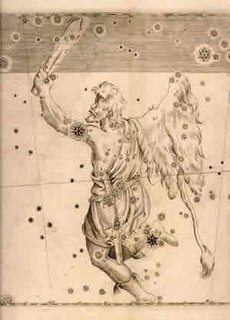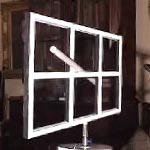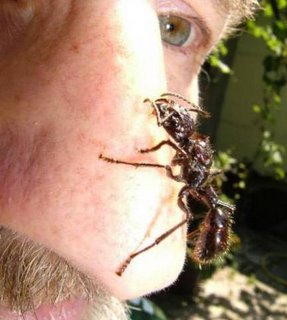
Soap bubbles are absolutely beautiful things... for about four seconds. After that, they've drifted off behind the sofa, been eaten by the cat, or impaled themselves on the nearest spider plant. We'd be able to get a much better look at them if only they could be persuaded to stick around a little longer. Well, they can. I came up with this method of viewing bubbles back when I was a student, and every time I've put it on TV I've been reminded of precisely how rubbish a medium TV is. The colours aren't saturated right, the contrast is poor - technically, it's a mess. But in person this is fabulously beautiful. Have a go and see for yourself.
What you needBubble mixture. People argue about precise recipes, but frankly – a cup of water with a squirt of washing up liquid in it will work just fine.
Some drinking straws.
A black bin liner
Masking tape
Tracing paper (NB. not greaseproof paper)
A table by a window - preferably a bay window.
What you do1. Cut a 40cm x 40cm square of bin liner, and tape it to the table – it needs to be absolutely flat and crinkle-free. Dribble a little bubble mixture onto the centre of the bin liner square, and use a straw like a squeegee to spread it out. You need to cover an area about 20cm x 20cm square, thinly and evenly.
2. Now dip another straw in the bubble mix, dot the centre of the bin liner, and, very gently, blow a bubble. Keep blowing until the bubble is about 10cm across, then carefully pull the straw out of the top of the bubble.
3. Half a bubble resting on a black sheet is surprisingly pretty, but there's a further trick to this activity. Roll the tracing paper into a cone shape, as large as you can. You need the narrow end to be large enough for your eye, and the other end to cover the soap bubble - so you may need to tape a few sheets of tracing paper together. Try to keep the seams as neat as you can.
4. By the time that's done your bubble will have burst, so blow another one, and then very gently lower the cone over it. Now look down at the bubble through the cone. How beautiful is that?
What's happening?The cone does two things. First, it shields the bubble from draughts and falling dust, so it tends to last longer, and the colours settle out more.
Secondly, it diffuses the light source - soap bubbles are best viewed under strong, even illumination from the side, and against a dark background. If your table's a bit dark you can shine a few desk lamps at the sides of your tracing paper, but I took these pictures in the light from a bay window.
As the liquid drains down the side of the bubble, you'll see rings of colour; the colour varies depending on the thickness of the bubble film, and hence how much it refracts light. Eventually - if your bubble lasts long enough - you'll see a central ring that's completely colourless. This is a film so thin, it's not refracting light at all - its thickness is less than the wavelength of the bluest light you can see!
It's called a 'black film,' and if you watch, it'll grow until the entire half-bubble is black. For a brief moment the bubble will be almost invisible - and then it pops.
 On March 29, 2006, a total solar eclipse will occur when the new moon moves directly between the sun and the earth. The moon’s shadow will fall on the eastern tip of Brazil, speed eastward across the Atlantic, through northern Africa, across the Mediterranean. We will link with The British School of Lome in Togo, West Africa to receive and analyse data they collect on temperature, humidity and light level.
On March 29, 2006, a total solar eclipse will occur when the new moon moves directly between the sun and the earth. The moon’s shadow will fall on the eastern tip of Brazil, speed eastward across the Atlantic, through northern Africa, across the Mediterranean. We will link with The British School of Lome in Togo, West Africa to receive and analyse data they collect on temperature, humidity and light level. More detailed maps and information of exactly where the shadow will pass can be found on this link and this Nasa site has fantastic multimedia presentations about eclipses.
More detailed maps and information of exactly where the shadow will pass can be found on this link and this Nasa site has fantastic multimedia presentations about eclipses.
 What you need:
What you need: This weekend surely has an animal theme.
This weekend surely has an animal theme. 
 Andy Darvill says: "This advice is based on my experience of helping students through all kinds of exams. The ideas work for most people, most of the time - but if I've learned anything from life, it's that everybody is different, and that you need to figure out what works for you."
Andy Darvill says: "This advice is based on my experience of helping students through all kinds of exams. The ideas work for most people, most of the time - but if I've learned anything from life, it's that everybody is different, and that you need to figure out what works for you." The ancient Greeks saw the figure of the Greek myth Orion in the night-time sky. There are several different stories about the birth of Orion. According to one version of the myth, Orion was the son of a poor shepherd called Hyrieus. Once, Zeus, Hermes, and Poseidon stopped by Hyrieus' house. Hyrieus was so generous with his guests that he killed the only animal he had - an ox.
The ancient Greeks saw the figure of the Greek myth Orion in the night-time sky. There are several different stories about the birth of Orion. According to one version of the myth, Orion was the son of a poor shepherd called Hyrieus. Once, Zeus, Hermes, and Poseidon stopped by Hyrieus' house. Hyrieus was so generous with his guests that he killed the only animal he had - an ox. 


 You will need:
You will need: Blame the term "zero-gravity" for this common misconception. Gravity is everywhere, even in space. Astronauts look weightless because they are in continuous freefall towards the Earth, staying aloft because of their horizontal motion. The effect of gravity diminishes with distance, but it never truly goes away. Oh, and while we're at it, it's also untrue that space is a vacuum. There are all kinds of atoms out there, albeit sometimes far apart (and this thin gas adds to the collective gravity budget, too!)IMAGE CREDIT: NASA
Blame the term "zero-gravity" for this common misconception. Gravity is everywhere, even in space. Astronauts look weightless because they are in continuous freefall towards the Earth, staying aloft because of their horizontal motion. The effect of gravity diminishes with distance, but it never truly goes away. Oh, and while we're at it, it's also untrue that space is a vacuum. There are all kinds of atoms out there, albeit sometimes far apart (and this thin gas adds to the collective gravity budget, too!)IMAGE CREDIT: NASA
 Soap bubbles are absolutely beautiful things... for about four seconds. After that, they've drifted off behind the sofa, been eaten by the cat, or impaled themselves on the nearest spider plant. We'd be able to get a much better look at them if only they could be persuaded to stick around a little longer. Well, they can. I came up with this method of viewing bubbles back when I was a student, and every time I've put it on TV I've been reminded of precisely how rubbish a medium TV is. The colours aren't saturated right, the contrast is poor - technically, it's a mess. But in person this is fabulously beautiful. Have a go and see for yourself.
Soap bubbles are absolutely beautiful things... for about four seconds. After that, they've drifted off behind the sofa, been eaten by the cat, or impaled themselves on the nearest spider plant. We'd be able to get a much better look at them if only they could be persuaded to stick around a little longer. Well, they can. I came up with this method of viewing bubbles back when I was a student, and every time I've put it on TV I've been reminded of precisely how rubbish a medium TV is. The colours aren't saturated right, the contrast is poor - technically, it's a mess. But in person this is fabulously beautiful. Have a go and see for yourself. In class today we were looking at the relationship between pressure and temperature. Did you have a go at making the pet cloud for the
In class today we were looking at the relationship between pressure and temperature. Did you have a go at making the pet cloud for the  You will need:
You will need:

 Schmidt Sting Pain Index or The Justin O. Schmidt Pain Index was created by
Schmidt Sting Pain Index or The Justin O. Schmidt Pain Index was created by 

